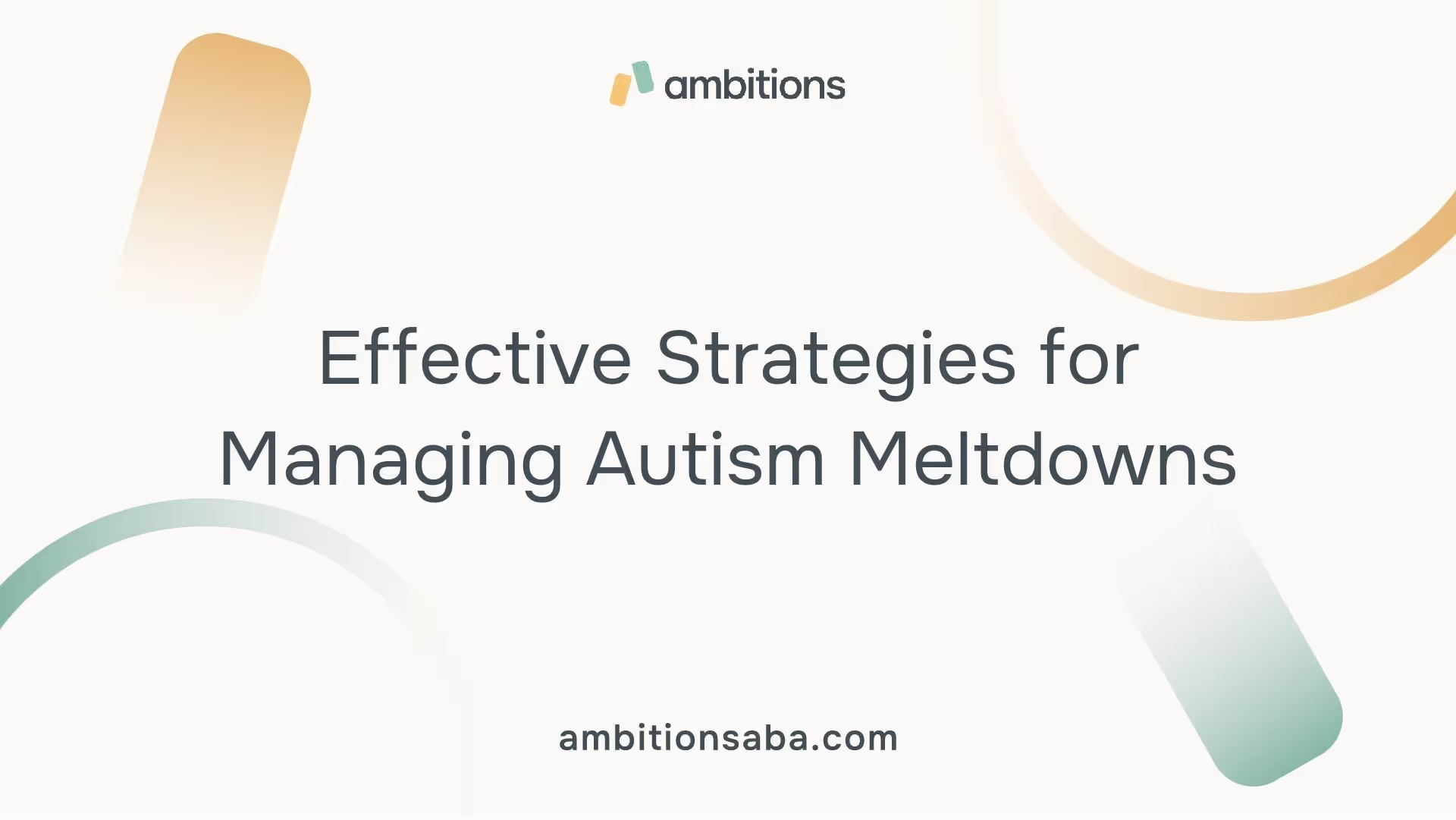Understanding Autism Meltdowns
Understanding autism meltdowns is vital for parents managing behaviors effectively. Recognizing the difference between meltdowns and tantrums is the first step.

Differentiating Meltdowns from Tantrums
Autism meltdowns are involuntary responses triggered by overwhelming sensory or emotional experiences. These moments can lead to a temporary loss of self-control, and they manifest through either verbal or physical outbursts.
In contrast, tantrums are deliberate behaviors aimed at getting attention or achieving a desired outcome. Unlike tantrums, meltdowns are not instances of bad behavior but rather understandable reactions to stress. Meltdowns arise from unmanageable stress rather than a direct challenge to authority or a manipulation tactic.
CharacteristicMeltdownsTantrumsNatureInvoluntaryDeliberatePurposeResponse to overwhelmSeeking attention or a specific outcomeControlTemporary loss of self-controlMaintaining some level of controlDurationCan last longer, varies per individualUsually brief
Triggers for Autism Meltdowns
Identifying triggers for autism meltdowns is essential for effective management. Common triggers include sensory overload, changes in routine, and emotional stressors.
Awareness of these triggers allows parents to adapt environments proactively. Recognizing and reducing potential stressors can be invaluable in managing autism meltdowns effectively. For further guidance, refer to how ABA promotes positive behaviors and understanding autism therapy options for tailored strategies in addressing these challenges.
Sensory Overload and Meltdowns

The Role of Sensory Processing
Sensory overload plays a pivotal role in autism meltdowns. It occurs when an individual is overwhelmed by external stimuli, causing feelings of anxiety and communication difficulties. This condition can lead to a strong urge to escape the situation. A buildup of stress over time can eventually trigger a meltdown.
For many individuals on the autism spectrum, sensory processing is not typical. They might be more sensitive to certain stimuli or less able to manage overwhelming environments. Triggers for sensory overload can include loud noises, bright lights, unfamiliar places, demands on time and energy, changes in routine, and fatigue.
Being mindful of these triggers is essential for parents. Recognizing the following common triggers can help prevent meltdowns:
TriggerDescriptionLoud NoisesSounds that may be tolerable to others can be overwhelming.Bright LightsIntense lighting can cause discomfort.Unfamiliar EnvironmentsNew places may lead to anxiety.Changes in RoutineAlterations in schedule can be unsettling.FatigueTiredness can decrease coping abilities.Lack of Coping MechanismsAbsence of strategies can heighten stress.
Managing Sensory Overload
To manage sensory overload effectively, it is crucial for parents to create a supportive environment. Taking steps to reduce or eliminate triggers can help individuals feel more at ease. Here are some strategies to consider:
Recognizing early signs of sensory overload is key to preventing meltdowns. Parents should be familiar with behavioral cues that indicate their child is becoming overstimulated, allowing for timely interventions [2]. Through these tailored strategies, families can better support their children in managing autism meltdowns effectively.
Creating Supportive Environments
Establishing supportive environments is crucial for managing autism meltdowns effectively. Sensory overload can be a significant trigger, leading to increased anxiety and communication difficulties. By creating sensory-friendly spaces and utilizing professional interventions, parents can help their children navigate these challenges with greater ease.
Sensory-Friendly Spaces
Creating sensory-friendly environments can significantly reduce the likelihood of sensory overload, which occurs when external stimuli overwhelm a person's coping abilities. This can lead to feelings of anxiety and an urgent desire to escape a situation. Elements that contribute to a calming sensory-friendly environment may include:
These adjustments can have a profound impact on anxiety levels in children with autism, promoting calmness and relaxation.
Element of a Sensory-Friendly SpaceBenefitsSoft lightingReduces stress from harsh fluorescent lightsQuiet spacesOffers a retreat for overstimulated childrenWeighted blanketsHelps with feelings of security and calm
Professional Interventions
Professional interventions play a vital role in managing meltdowns. Therapy approaches, including behavioral therapies and physical therapies, focus on emotional regulation, sensory processing, and coping strategies. Each of these elements contributes to enhancing overall coping skills and functioning.
These approaches provide children with the tools they need to cope with stressful situations, making it easier for them to manage potential meltdowns.
By creating safe, sensory-friendly spaces and incorporating professional therapies, parents can significantly improve their child’s ability to cope with overwhelming situations. This proactive approach is an essential step in fostering a supportive environment that benefits children with autism in their daily lives. For more resources on autism therapy options, check out our article on understanding autism therapy options.
Effective De-escalation Strategies
Dealing with autism meltdowns can be daunting for parents. Implementing effective de-escalation strategies can help manage these situations more effectively. Here, we highlight calming techniques and the use of visual aids and sensory tools that can make a significant difference.
Calming Techniques
Various calming techniques can help reduce anxiety and promote a sense of calm during a meltdown. Parents should focus on methods that empower the child and make them feel safe. Some effective techniques include:
Calming TechniqueDescriptionReflective ListeningValidates feelings through active listeningOffering ChoicesProvides a sense of controlBreathing ExercisesReduces anxiety through focused breathingCreating a Quiet SpaceSafe retreat for calming down
Visual Aids and Sensory Tools
Visual aids and sensory tools can provide significant support during meltdowns. They help to create a calm environment that minimizes stress and overwhelm.
Visual AidPurposeCalming PicturesProvide emotional understandingSensory CornersOffer comfort and reduce sensory overloadInteractive ToolsFacilitate self-soothingVisual TimersEnhance predictability and reduce anxiety
By integrating these de-escalation strategies into everyday routines, parents can significantly improve their ability to manage autism meltdowns effectively. Consider exploring additional resources on the impact of ABA therapy on families and how ABA promotes positive behaviors to further enhance understanding and support for children on the spectrum.
Preventing and Managing Meltdowns
Addressing autism meltdowns effectively requires familiarity with early warning signs and the utilization of calming tools. Recognizing these elements can greatly aid parents in providing appropriate support.
Early Signs of Meltdowns
Before a meltdown escalates, there are several signs of distress that might appear. Being aware of these can provide a crucial window for intervention. Common early signs include:
Signs of DistressDescriptionPacingRepeatedly walking back and forthRepetitive QuestioningAsking the same question multiple timesRockingSwaying back and forth, often a self-soothing behaviorBecoming Very StillSudden lack of movement, also known as the "rumble stage"
During the "rumble stage," there is a good opportunity to apply strategies like distraction, diversion, calming techniques, and maintaining a calm environment to avoid escalation.
Tools for Calming During Meltdowns
Having specific tools on hand can make a significant difference when a meltdown occurs. Here are several effective tools to consider:
Calming ToolDescriptionWeighted BlanketsProvides comfort and a sense of securityNoise-Canceling HeadphonesReduces auditory stimuli that may trigger anxietyFidget ToysEncourages focus and provides sensory engagementVisual SchedulesHelps in understanding the sequence of activities, reducing anxiety over transitions
Additionally, creating sensory-friendly environments can significantly lower the chances of sensory overload. Elements such as soft lighting, quiet spaces, and calming textures can promote tranquility.
In situations where meltdowns occur, parents can utilize strategies like reflective listening to validate their child's feelings. This can involve repeating back what the child expresses to show understanding and enhance communication during stressful moments.
For more resources on supporting children with autism, consider reviewing our articles on creating structure in autism therapy and navigating healthcare for autism.
Supporting Children with Autism
Supporting children with autism involves providing emotional support and seeking professional assistance to manage challenges, including meltdowns. Understanding these aspects can significantly improve the well-being of both the children and their families.
Providing Emotional Support
Emotional support is essential for children with autism as they navigate various social and sensory challenges. Parents can foster a nurturing environment by practicing active listening. Reflective listening involves repeating back what the child is expressing, which helps validate their feelings. This technique enables children to feel heard and understood, which can be especially comforting during difficult moments.
Creating sensory-friendly environments can also greatly enhance emotional well-being. Elements such as soft lighting, quiet spaces, and weighted blankets help reduce anxiety and promote calmness. Here are some practical tips for providing emotional support:
Emotional Support StrategiesDescriptionReflective ListeningAcknowledge feelings to validate their emotions.Offer ChoicesHelp the child regain a sense of control by offering options.Create Calm SpacesEstablish sensory-friendly areas for relaxation.
Seeking Professional Assistance
Accessing professional interventions plays a critical role in helping children with autism manage meltdowns effectively. Approaches such as therapy, behavioral therapies, and physical therapies focus on emotional regulation, sensory processing, and developing coping strategies [3]. Engaging with trained professionals can also provide parents with resources to support their child's development.
When considering professional assistance, parents can refer to various resources available for autism support. For instance, engaging with specialists who understand the unique needs of children with autism can facilitate better outcomes in emotional and social areas.
Additionally, parents should seek out resources that provide information on effective strategies for managing meltdowns. This could include recommendations for tools such as deep pressure techniques, noise-cancelling headphones, or weighted blankets that can help calm children during critical moments [6]. By combining emotional support with professional guidance, families can create a comprehensive approach to manage autism meltdowns effectively.
For more insights on developing essential skills and enhancing communication, check out our articles on autism communication tips for caregivers and developing life skills in autism.
References
[2]:
[3]:
[4]:
[5]:
[6]:



